IntroductionIn this article, I will be looking at the transmissions found in cars, and how they affect performance and economy. Table of ContentsThe Vehicle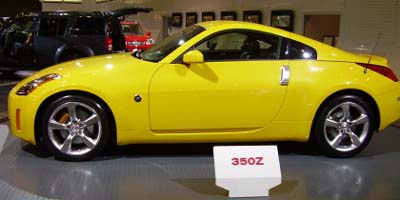 For the majority of this article, I will be using a 2006 Nissan 350z Coupe as an example vehicle. In stock form, it comes with a 6-speed manual transmission and a 3.538:1 rear axle ratio. Below is a graph showing the torque and power curves of the engine, a 3.5L 287hp VQ35DE V6. 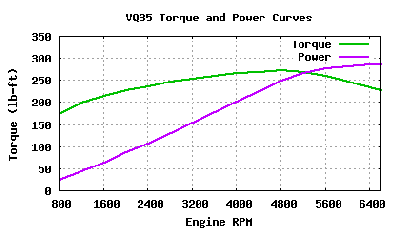
Nissan VQ35DE torque curve. Transmission FormulaeRatio SpreadThe ratio spread is the ratio of two different gear's ratios, such as second gear and third gear, or first gear and top gear. The overall ratio spread directly affects the range of speeds that the transmission can allow the vehicle to travel at, and the ratio spread between each gear affects the change in acceleration force after each gear change. Ideally, the ratio spread between first gear and top gear would be very high, so that the car would have high acceleration at low speeds, and a high top speed without causing the engine to redline. Also, the ratio spread between each gear should be low, so that the engine can be kept revving near its power peak while the vehicle passes through a wide range of speeds. The only way to have a large overall ratio spread and a small ratio spread between each gear is to have numerous gears. A close-ratio transmission will have a small overall ratio spread, by definition. Likewise, a wide-ratio transmission will have a large ratio spread. 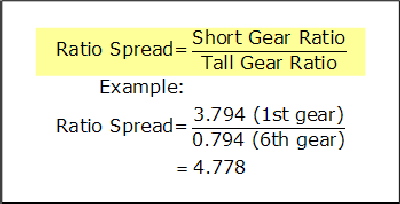
Ratio spread formula. RPM Change When Shifting GearsWhen a higher gear is selected in the transmission, the engine RPM drops. The RPM after the shift can be calculated if both gear ratios and the RPM before the shift are known. The process can be reversed to determine the RPM after gearing down. The formulae for calculating the ratio spread and RPM change are shown below. 
RPM change formula. Gear Ratio SelectionThe gear ratios in a transmission are chosen based on what rev range the engine makes power, and the speeds the vehicle will most often be traveling at. Typically, first gear has a very high ratio, which allows the engine to rev up quickly and get into its power band. This is especially true in trucks where a high gear ratio is needed to get heavy loads moving, or to climb a very steep hill. The remaining gear ratios are chosen in such a way that the vehicle can have high acceleration at various vehicle speeds. The ratio spread between each gear decreases from first gear to top gear. This is because the engine's ability to exert a force at a certain speed follows a curve which flattens with increasing speed. On regular production road cars, the top gear ratio is usually set to keep the engine revving at an ideal RPM for good fuel economy at freeway speeds. A wide-ratio transmission is normally used in applications where the vehicle will be traveling at a wide range of speeds, while a close-ratio transmission will be used where the speed range of the vehicle is fairly narrow, such as a race track. A wide-ratio six speed transmission can do what a wide-ratio three speed a close-ratio three speed can do, at the same time. Below is a plot of the gear ratios of the following transmissions:
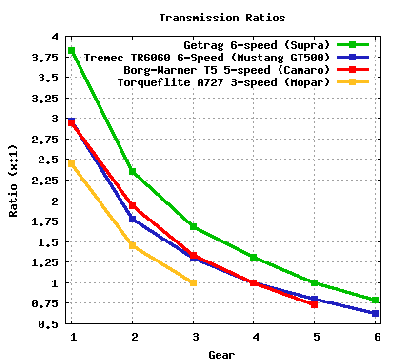
Gear ratios of various transmissions. Note that Supra's 6-speed does not have the same ratios as the 6-speed in the Mustang GT500. 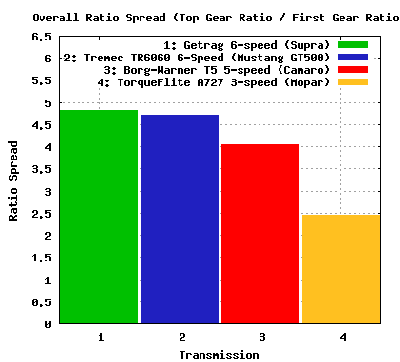
Overall ratio spread for each transmission. Note that the 3-speed does not have nearly the same ratio spread as the 6-speeds. 3-Speed Versus 6-SpeedIt is intuitive that a transmission with more gears than another will be better, but it may not be totally clear as to why that is. To make the comparison, I will use the stock 6-speed manual in the 350z, along with an old 3-speed manual from an older Nissan vehicle. Below is a table showing the gear ratios of each transmission.
Below is a graph showing the force that the 350z puts to the pavement versus the speed that the car is traveling. Each arc represents a selected gear in the transmission. First gear is the highest, narrowest curve, and top gear is the lowest, widest curve. The beginning of the arc is when the engine is at 1600RPM (chosen by me to keep the graphs clean) in that particular gear, and the end of the arc is when the engine hits its redline of 6600RPM. A higher force implies a higher acceleration at that speed. 
Road force with the VQ35DE turning the 3 speed and 6 speed transmissions. Note that at 75mph, there are 4 gears to choose from with the 6 speed, while the 3 speed offers only two. The above graph clearly shows the superiority of the 6-speed in terms of acceleration. The 6-speed has significantly better acceleration than the 3-speed at numerous vehicle speeds, especially at 45-60mph and 85-100mph. The graph below shows the engine RPM versus the speed of the car. Note that the 6-speed is much better at keeping the engine revving high than the 3-speed. This is because the ratio spread between each gear is much lower. The fact that the engine can be kept revving high allows much more average power to be put to the road while the car accelerates. This was already seen in the previous graph. 
Engine RPM versus vehicle speed for both transmissions. The large RPM drops on the 3-speed's gear changes are from the high ratio spread between the gears. It can be seen in the above graph that at 60mph, the 6-speed can have the engine turning as low as 2150rpm, while the 3-speed can only bring it down to 2700rpm. To correct this, I will change the gears in the 3-speed car's rear axle from the stock 3.538:1 to 2.809:1. Below is a graph showing the effect of changing the rear axle gear on the 3-speed. 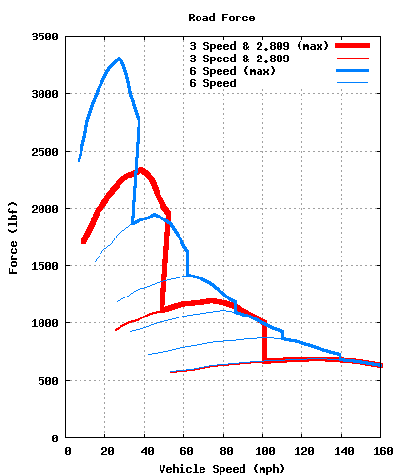
Road force with the VQ35DE turning the 3 speed and 6 speed transmissions. Note that in order to have the same top gear cruise RPM as the 6-speed, the 3-speed has had to sacrifice acceleration all across the board. It can clearly be seen that the 3-speed is now very far behind the 6-speed in terms of acceleration. This shows that transmissions with very few gears can give a car good acceleration or good fuel economy, but not both at the same time. Continuously Variable TransmissionsA continuously variable transmission is a transmission that uses a belt on two conic pulleys or a set of rollers to provide an infinite number of ratios. An ideal CVT has an infinite ratio spread, meaning that it could allow the engine to run while the vehicle is at rest (∞:1) and allow the vehicle to drive at an infinitely high speed (0:1). Real CVTs have a finite ratio spread, and use an engagement similar to a torque converter in an automatic transmission to allow the car to be at rest and drive at low speeds. 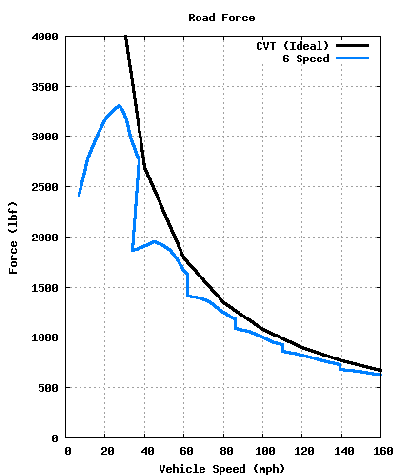
The ideal CVT can put the engine's peak power to the road at all speeds. It is superior to the 6-speed. CorneringWhen going around a corner, there is a maximum speed that the car can go around it. It is therefore important that the transmission can keep the engine revving at a suitable RPM at that speed. Below is a diagram showing the 3-speed car and 6-speed car going around a corner at 80mph. 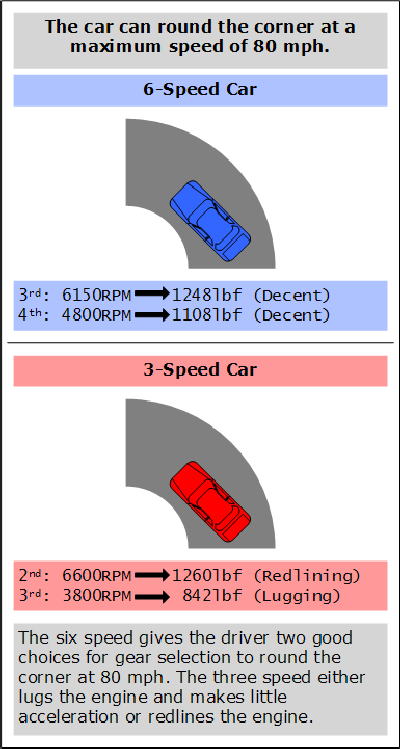
When the cars are going around a corner at 80mph, the 6-speed has the advantage because it can keep the engine revving fairly high without redlining. The 3-speed can either redline in 2nd gear, or lug in 3rd gear. Drag RacingIn drag racing, the time it takes to shift gears is very significant. The faster the vehicle is, the more significant the gear change time becomes relative to the elapsed time down the strip. Because of this, most high performance drag cars only go through three gears (two changes) when going down the ¼ mile. The fastest drag cars do not shift gears at all, but rather have a hydraulic drive system that varies the transfer of power from the engine to the drivetrain. A drag race engine must be tuned to provide a high amount of power at any RPM to provide the necessary acceleration while pulling through so few gears. Transmissions with fewer gears also tend to have less friction, which allows more of the engine's power to make it to the pavement. ConclusionTransmissions have a direct effect on a vehicle's ability to accelerate. An ideal transmission can keep the engine revving near its power peak when the vehicle is driving at various speeds. The gear ratios are chosen based on what speeds the vehicle will be traveling, and having more gears raises the speed range that the vehicle can accelerate most quickly. See Also |
||||||||||||||||||||||||
|
|
|||||
|
|